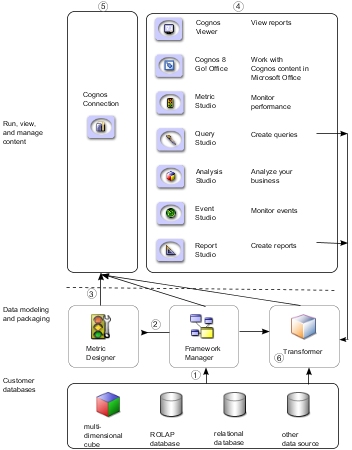
When you view or create a report, you are viewing and manipulating data stored in your organization’s databases. The following diagram explains the steps involved in using Cognos 8.

In Framework Manager, the modeler ensures that metadata is presented in a manner that business users can understand it. Modelers import the metadata from one or more databases, and then add to the model to meet user requirements.
In Metric Designer, the modeler identifies the data items and calculations that form the targets and actual results for each metric.
The modeler then publishes and updates packages to Cognos Connection so that authors can use them to create reports, agents, and scorecards.
Business users and report authors use the published packages to understand their business data.
Users run, view, and manage their content in Cognos Connection. Depending on their security permission they may be able to simply run and view reports or manage schedules, portal layout, and other users’ permissions.
In Transformer, you can leverage queries in published packages, queries fromCognos 8 reports, and personal data sources, such as Microsoft Excel, to create a unique, focused model of your business. Transformer is Cognos’ industry leading OLAP modeling tool, which is designed so that business users can be self-sufficient in modeling a view of the business that suits the needs of their department or specialty.
For more information, see the Cognos 8 Architecture and Deployment Guide.
When authors create a report, they are actually creating a report specification. The report specification is an XML representation of the queries and prompts that are used to retrieve data, as well as the layouts and styles used to present the data. For simplicity, the report specification is called the report.
Report specifications can be useful to report authors for troubleshooting.
For information about working with report specifications, see the Report Studio Professional Authoring User Guide or the Report Studio Express Authoring User Guide, and the Cognos 8 Software Development Kit Developer Guide.
Because stored data is typically designed for storage, and not for reporting, a data modeler uses Framework Manager to create metadata models. A model structures, adds to, and manages data in ways that make sense to business users. For example, a model defines business rules, data descriptions, data relationships, business dimensions and hierarchies, and other administration tasks.
Planning and creating a model is an important task that should be performed by a modeler or a modeling team familiar with both the database structure and the needs of the business users.
After the metadata model is defined, modelers create a package to make metadata available to report authors. Each package must contain all the information that a specific user or group of users needs to create reports. For example, one package can contain human resources data, and another sales data. When users open an authoring studio, they must select which package to use. Each report can contain data from only one package.
After a package has been made available in Cognos Connection, a Transformer modeler can begin to design a multidimensional PowerCube for more summarized analysis of the business. The queries can be created directly in Transformer using metadata from any published package. A business specialist could also design their own model for more focused analysis and combine metadata from different packages and even include personal data using flat files.
A more refined query intended for Transformer modeling could be authored by a business specialist by creating a report in Query Studio or Report Studio. That report can then be accessed in Transformer allowing the business specialist full control over changes to the report, and therefore the query, rather than relying on the Framework Manager administrator for changes. Once the multidimensional design is complete, Cognos 8 security can be added with dimensional filtering and the PowerCube built. The PowerCube can then be published to Cognos Connection just like any other package, making it available for multidimensional analysis and reporting.
For information about data modeling, see the Framework Manager User Guide, the Metric Designer User Guide, or the Cognos 8 Transformer User Guide.
